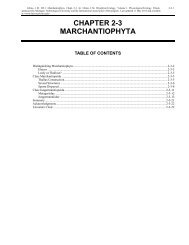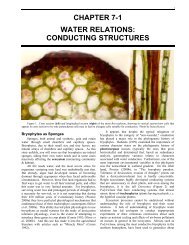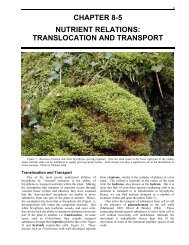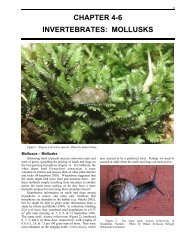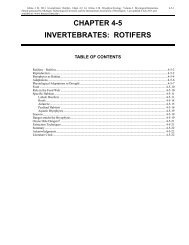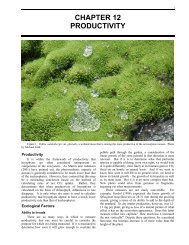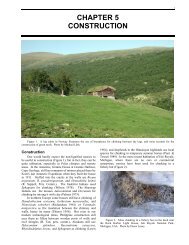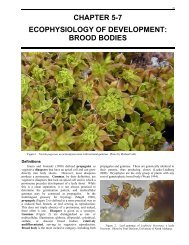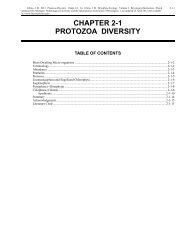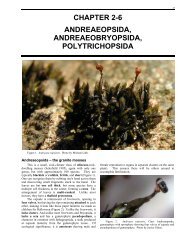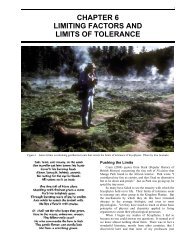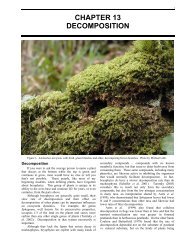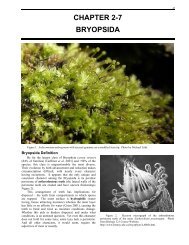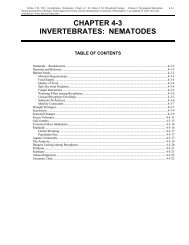114 Chapter 5-9: Ecophysiology <strong>of</strong> Development: SporophyteFigure 16. Expanding setae with capsules on Lophocoleaheterophylla. Photo by Michael Lüth.Since the <strong>sporophyte</strong> is dependent upon fertilization,the signal for fertilization, to be adaptive in mosses withshort life cycles, must be coupled with the signal for<strong>sporophyte</strong> formation. Interesting information might resultfrom testing responsiveness <strong>of</strong> mature gametophytes tosugar and N concentrations as signals for gametogenesis.Since early <strong>sporophyte</strong> <strong>development</strong> usually follows aconsistent time sequence after gametogenesis, it isreasonable to hypothesize that signals for seta formationand gametogenesis are the same in many species, especiallyannual ones.Water NeedsThe seta functions to transfer water from thegametophyte to the developing <strong>sporophyte</strong>. In somemosses (Funaria and Polytrichum), the center <strong>of</strong> the seta isa hydroid cylinder with a leptoid sheath surrounding it(Hébant 1977). However, it appears that the majority <strong>of</strong>moss setae have only the hydroid cylinder (Vitt 1981).Hébant (1977) suggested that the foot acts as a pump todrive water and other substances upward toward thedeveloping capsule.The maturation <strong>of</strong> the <strong>sporophyte</strong>, although appearingto be a relatively dry structure at maturity, is dependent onavailable water. Sporophyte abortion <strong>of</strong>ten results frominsufficient water at a crucial <strong>development</strong>al time. InSphagnum, Sundberg (2002) found that <strong>sporophyte</strong>production was positively correlated with precipitationamount during the previous summer, suggesting that it wassensitive to drought during gametangium formation andfertilization. He found that larger patches had higherprobability <strong>of</strong> producing <strong>sporophyte</strong>s, suggesting that thelikelihood <strong>of</strong> having both sexes was greater, but could italso be possible that retention <strong>of</strong> moisture was facilitatedby larger patches? Sporophyte maturation was likewisenegatively affected during their summer <strong>of</strong> maturationwhen droughts caused them to dry prematurely. Hesuggested that some species could benefit from earlymaturation that permitted them to mature before effects <strong>of</strong>drought could abort <strong>development</strong>.In the Mojave Desert, the opposite effect appears to betrue. Following an unusually heavy summer rainstorm,approximately 50% <strong>of</strong> the <strong>sporophyte</strong>s <strong>of</strong> Grimmiaorbicularis aborted at a time when they were still in theseta elongation phase. Stark (2001) suggested that theabortions may have been due to the dehydrationrehydrationcycle during the hot summer when setae wereat an abnormally advanced stage <strong>of</strong> <strong>development</strong>. Repairfrom prior desiccation under hot conditions could be toogreat a cost in energy or nutrients, preventing <strong>sporophyte</strong>maturation.HormonesIn addition to requirements for carbohydrates andnutrients from the gametophyte, capsule <strong>development</strong>seems to be controlled by growth regulators. Or are thesegrowth regulators controlled by the carbohydrates andnutrients? There is evidence that sugar stimulates hormoneproduction. Protonemata can be maintained fromsporangia tissue culture by re-culturing every few days(Bauer 1963). Buds from these protonemata yieldgametophores. Glucose can be used to stabilize thesporangium factor in the protonema, and when theprotonema is allowed to bud, the sporangium factorbecomes active. Bauer concluded that the control factor isnot a hormone-like substance passed from the sporangiumto the protonema, because after numerous culturings <strong>of</strong> theprotonema the supply would be exhausted. Therefore, thesubstance must propagate itself in the presence <strong>of</strong> the sugarsupply. Likewise, gametophyte callus tissue under culturewith high sugar will produce <strong>sporophyte</strong>s (Bopp 1968).Could it be cytokinins that delay capsule expansion upon aseta on a growing gametophytic moss?Once the capsule develops, it provides a feedbackmechanism, some sort <strong>of</strong> regulator, that inhibits seta<strong>development</strong> (Redfearn & Meyer 1949). Removal <strong>of</strong>Funaria hygrometrica capsules results in cessation <strong>of</strong> setaelongation (French & Paolillo 1975 a, b). However thiselongation can be restored by application <strong>of</strong> benzyl adenine(BA) alone or with indole acetic acid (IAA). Whencapsules were retained, BA prolonged seta meristematicactivity and suppressed capsule expansion. And, assuggested above, high cytokinin levels antagonize capsuleexpansion (French & Paolillo 1975a).IAA and photoperiod also influence seta elongation.Setae <strong>of</strong> Pogonatum aloides grew longer in long days (18hours) than in short days (6 hours) (Hughes 1962). Thisgrowth was due to an increased cell length. Pelliaepiphylla, though, had maximum seta elongation in shortdays when sprayed with aqueous IAA and GA 3 (Kaufmanet al. 1982). These applied hormones may have overcomethe auxin oxidases present, which would be inhibited bylong days.Crombie and Paton (1958) suggested that age affects<strong>sporophyte</strong> elongation in Pellia epiphylla. Hormones mayaccumulate until their concentrations are high enough tostimulate growth. Certain inhibitors may also need time tobreak down and be removed.We have shown that IAA is important in seta<strong>development</strong> in another way as well. Gravitropism <strong>of</strong> theseta in Pellia epiphylla exhibits lateral redistribution <strong>of</strong>IAA, with movement to the lower side <strong>of</strong> a horizontal seta(Thomas et al. 2002). This is an important aspect <strong>of</strong>orienting <strong>sporophyte</strong>s that are originally positionedhorizontally, such as those growing on vertical or slantingsubstrata. However, not all bryophytes have verticallyoriented setae on vertical substrata (Figure 17).
Chapter 5-9: Ecophysiology <strong>of</strong> Development: Sporophyte 115archegonium. But how has this absence <strong>of</strong> gametophyteleaves influenced the appearance <strong>of</strong> a Buxbaumia<strong>sporophyte</strong>? And what property causes the Buxbaumia<strong>sporophyte</strong> to exhibit its strong bilateral symmetry? Sincethe capsules seem to orient themselves with their flatsurfaces facing the light, perhaps we should expect it to becontrolled by a hormone that responds to light. Are therecryptochromes or phytochromes in the capsule that causethe directional response?Figure 17. Setae and capsules <strong>of</strong> Ulota coarctata on avertical substrate, demonstrating apparent lack <strong>of</strong> gravitropism inthese setae. Photo by Michael Lüth.Capsule ShapeCapsule shape is under genetic control <strong>of</strong> the<strong>sporophyte</strong>, as demonstrated by the transplant experiments<strong>of</strong> Arnaudow (1925), but the shape can also be highlyinfluenced by the calyptra. In Polytrichum juniperinum,the splitting <strong>of</strong> the inner sheathing layer <strong>of</strong> the calyptracauses the capsule to develop bilateral symmetry, whereasin Funaria hygrometrica splitting <strong>of</strong> the calyptra has noeffect on capsule shape (Paolillo 1968).This behavior suggests to me that ethylene could be acontrolling factor. The capsule expands the most on theside <strong>of</strong> the slit. Ethylene inhibits cell division and, at somestages, also cell expansion. Since ethylene is a gas, it canescape more easily on the side with the slit than on theclosed side, thus permitting more growth on the split side.The fact that Funaria does not respond to a split calyptracould result from its smaller, thinner calyptra and the factthat the calyptra covers very little <strong>of</strong> the expanding capsule,whereas the calyptra <strong>of</strong> Polytrichum covers the entirecapsule.NeotenyNeoteny (retention <strong>of</strong> juvenile characters in adult)occurs in such mosses as Buxbaumia (Figure 18) andseveral species <strong>of</strong> Pogonatum (Figure 19) where thegametophore is reduced and persistent protonemata supportthe <strong>sporophyte</strong>. The genetic control <strong>of</strong> such a phenomenoncould be an evolutionary and physiological revelation. Isneoteny the result <strong>of</strong> the loss <strong>of</strong> a gene necessary to beginthe gametophore process, or is there a gene that results insomething that blocks the <strong>development</strong>? Theoretically, ifthis link were altered to "normal" condition, the mosswould develop into the leafy gametophore typical <strong>of</strong> itsancestors. Being able to override this neoteny mechanismwould be particularly instructive in the case <strong>of</strong> Buxbaumia(Figure 18), which has a unique capsule structure andseems to have no close relatives.The <strong>development</strong> <strong>of</strong> a <strong>sporophyte</strong> is dependent uponthe surrounding tissue <strong>of</strong> the calyptra, and prematureremoval <strong>of</strong> a calyptra can result in capsule abortion orabnormalities. But what is the effect <strong>of</strong> the surroundinggametophore tissues on the <strong>development</strong> <strong>of</strong> the young<strong>sporophyte</strong>? Surely perichaetial leaves surrounding adeveloping embryo within an archegonium must exertsome influence as that embryo emerges from theFigure 18. Sporophyte <strong>of</strong> Buxbaumia aphylla growingdirectly from archegonia on the protonema. Photo by MichaelLüth.Figure 19. Persistent protonemata with plants <strong>of</strong> Pogonatumaloides. Photo by Michael Lüth.In some species where the seta fails to elongate, thecalyptra is retained throughout capsule <strong>development</strong> andexpands as the capsule does, covering it completely atmaturity. In several xerophytic species we find that atmaturity these capsules are <strong>of</strong>ten shed in their entirety,including Pleuridium (Figure 20; Claudio Delgadillo, TerryHedderson on Bryonet 26 May 2006) and some species <strong>of</strong>Physcomitrella (Jerry Jenkins on Bryonet 26 May 2006).All <strong>of</strong> these factors are hardly sufficient to explain themarked differences between the <strong>sporophyte</strong> andgametophyte. A major difference arises as a result <strong>of</strong> thenumber <strong>of</strong> cutting faces <strong>of</strong> the apical cell, and Bauer (1963)feels that this is a major key to the difference between thegametophyte and <strong>sporophyte</strong>. However, we have nophysiological explanation for the change in number <strong>of</strong>cutting faces. We must now look into the cell for changesin polarity and cellular organization and trace thebiochemical pathway that signals them.



